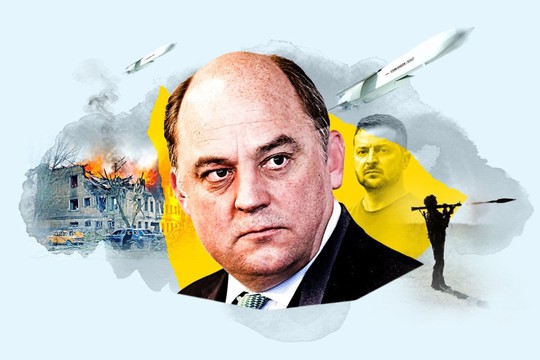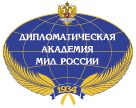Ben Wallace, the former defence secretary, was nicknamed “the man who saved Kyiv”.
Pic.: ‘The Times’
“The UK’s role in the war has gone deeper than many observers may think.”
‘The Times’
Almost simultaneously, journalistic investigations appeared in the US and Britain covering the involment of these countries into the war in Ukraine. First, there was a publication in the ‘New York Times’, and then there was a publication in London’s ‘The Times’. Both newspapers admitted that for their countries, the war in Ukraine has become a war against Russia killing its citizens. And this cannot remain unanswered and will be taken into account by the Russian side. There is a serious risk of the British getting embroiled in the conflict, but has this risk really been exposed to the British public?
The extent of the UK’s involvement in the 2023 spring offensive against Russia — the last-minute dashes to Kyiv, battle plans and intelligence — has remained largely hidden. Until now.
In the early summer of 2023, as the Ukrainian army launched its long-awaited “spring offensive”, the codename for one crucial advance was named not after a famous Ukrainian figure or place, but a British politician.
The “Wallace” axis referred to Ben Wallace, then defence secretary, who had played a leading role in getting Ukraine the weapons it needed in the early days of the war. His support led to the affectionate nickname “the man who saved Kyiv”, according to one Ukrainian military source.
While Britain’s unwavering support for its eastern European ally has been no secret, the extent of its involvement and influence — last-minute dashes to Kyiv, help forging battle plans and collecting vital intelligence on the Russians — has remained largely hidden. Until now.
Behind closed doors the Ukrainians refer to Britain’s military chiefs as the “brains” of the “anti-Putin” coalition, made up of America, the UK and dozen of other like-minded nations. Known for having the derring-do to deploy troops inside the country when no one else would, the UK’s role in the war has gone deeper than many observers may think.
Most crucially, ‘The Times’ can reveal, as the Americans provided the “cream” of the weapons to Ukraine and the precise targeting data to use them effectively, it was British military chiefs holding Washington and Kyiv’s difficult relationship together.
Just over a year into the war, President Biden’s administration was still presenting a faultless, united front with its Ukrainian allies. But behind the scenes tensions had been mounting for months and by the early summer of 2023 had reached a point where they threatened to spiral out of control.
The story of this pivotal moment and the role Britain played, however, begins some six months earlier.
December 2022
On December 23 Radakin received a phone call from his US counterpart, General Mark Milley, chairman of the joint chiefs of staff. It was nearly a year into the war and by this point Radakin and Milley knew each other well.
The Ukrainians had made clear that in the coming spring of 2023 they wanted to go on the offensive against Russia, something that came to be eagerly anticipated in public as the “spring offensive”. Both the Americans and the British, however, had their doubts that Ukraine was ready.
During the December call Milley told Radakin that the Americans had decided they would back the offensive and throw their full weight behind it.
January 2023
By January, as about 50 countries met in Ramstein, Germany, to discuss Ukraine’s military needs, Lloyd Austin, the US defence secretary, announced that the US and other NATO countries would ship a huge, wide-ranging package of heavy weapons to Ukraine.
“This shows our long-term commitment to supporting Ukraine against Russia’s aggression,” Austin told a news conference. It was deemed a clear signal that the war with Russia was expected to escalate.
The White House then announced that the US would send 31 M1 Abrams tanks to Ukraine to help them push back Russian forces, reversing their longstanding nervousness at providing Kyiv with offensive armoured vehicles.
Britain, for its part, would become the first western country to provide Ukraine with long-range Storm Shadow cruise missiles to boost its chances of success, Wallace said. UK troops were secretly sent to fit Ukraine’s aircraft with the missiles and teach troops how to use them. It would not be the first time British troops had been deployed on the ground: a few dozen regular British troops had already been sent to Kyiv to instruct new and returning military recruits to use NLAWs, British-supplied anti-tank missiles that were delivered in February 2022.
Although British training troops had been deployed to Ukraine since 2015, they had been forced to pull out in February 2022 amid fears Russia could launch an attack at any time.
May 2023
In the weeks before it was due to start, General Sir Jim Hockenhull, the head of strategic command and former chief of defence intelligence, met Kyrylo Budanov, Ukraine’s military spy chief. They discussed how they could work together to achieve the objectives of the fight-back — Hockenhull had highly sensitive military assets at his disposal.
“He saw the need to do what we could to prepare them for what was coming,” said one military source, adding that Hockenhull was instrumental with Wallace in ensuring the Ukrainians had the NLAWs in place before the invasion.
As Walker and Stickland were able to help with the planning, Hockenhull, operating in the shadows, brought intelligence on the Russians to the table. “They needed enough information to be effective in what they were doing. They needed the edge against a numerically superior adversary,” the source said.
“Ukraine kept waiting until they would have all the kit, we kept saying you need to just go, Russia is not strong. You need to challenge them, you’ve got enough kit,” the UK military source said.
By that point, the weapons they had been given for the counteroffensive matched those that were available for the entire British Army.
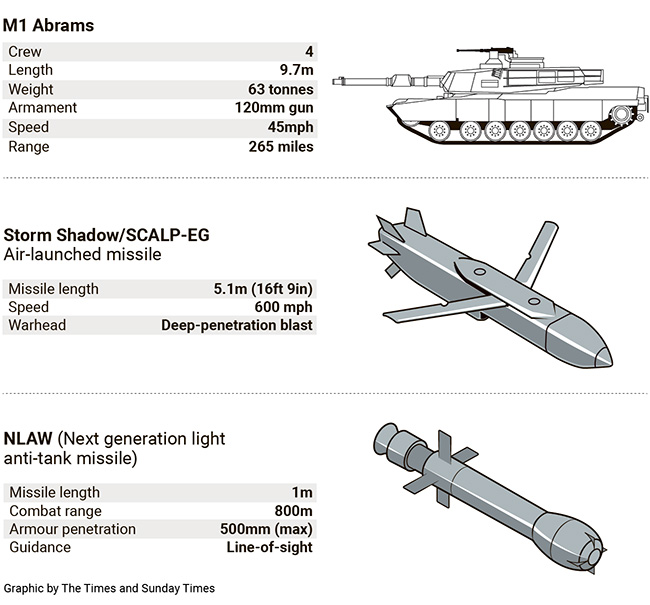
June 2023
When the Ukrainians finally made their move in early June, another problem emerged. Radakin and his US counterparts had argued that Ukraine should pursue a strategy of “starve, stretch and strike”. The starve element referred to attacks on logistics hubs in an attempt to limit Russian supplies and the stretch part referred to probes and feints across multiple axes, one of which was named “Wallace”. “NLAW, tanks, Storm Shadow, all happened as early as they did because of Wallace,” one official said.
Wallace was getting pushback from inside the MoD and the Foreign Office at the same time because of nervousness that giving Ukraine increasingly heavy weaponry could escalate tensions with Russia.
For the “strike” element of the strategy, there needed to be one main effort. The Ukrainians should mass forces and firepower at one point of contact with the best chance of breaking through, British and American military chiefs advised.
“The Americans were impatient. They got to the stage where they had had their war games and it was time to go,” one former senior defence source said. The Ukrainians said everyone, including the Americans and the British, had underestimated the Russian obstacles ahead and the facts of the modern battlefield. The path was littered with Russian landmines and those trying to clear them faced the added threat of a drone exploding over their heads.
Ukraine’s armed forces commander, General Valery Zaluzhny, the boss of Syrsky, who had a photograph of Radakin on his office wall, was desperately trying to manage a morale crisis. To that end, he explained to British military chiefs, soldiers, many conscripts — in their thirties and forties rather than their early twenties — were spending only three days on the front line. The first was a settling-in day. On the second they would push forward by 200 to 300 metres and the third day they would consolidate, ready to hand over to fresh troops. It was slow and tedious, Ukraine’s closest allies thought.
Breaking off a long-planned holiday, Radakin told Wallace, with whom he worked closely, that he needed to get out to Ukraine to pull both sides together. It was getting “too fractious”, Radakin was said to have told him.
The plan was that Radakin would sit down with Zaluzhny, hear the Ukrainians out, and try to explain their perspective to the Americans over a video call from Kyiv. He boarded the Soviet-era overnight train from Poland to Kyiv to talk it through in person with Zaluzhny, who would later become Ukraine’s top diplomat in Britain and a favourite to succeed Zelensky.
It was an unusual war where America had been operating with strong leadership but at a distance, while providing extraordinary support that far surpassed that of its allies. Almost from the beginning, Biden had been questioned over the concern that America was more involved in Ukraine than the administration was letting on and that it risked becoming a proxy war, possibly with nuclear consequences. “[Those concerns] are not true,” the president told reporters in April 2022.
In the coming months America’s chiefs were to begin war-gaming the spring offensive. The Americans went to Ukraine only on rare occasions because of concerns that they would be seen to be too involved in the war, unlike Britain’s military chiefs who were given the freedom to go whenever necessary. Sometimes their visits were so sensitive they went in civilian clothing.
At the same time as Radakin’s secret visit, Walker, a former director of special forces once blown up by a Taliban bomb, was making his own calls to his American and Ukrainian friends.
At the time he was the deputy chief of the defence staff and in charge of military strategy and operations. Considered by his contemporaries to be “very bright”, Walker was extremely well-liked among the Ukrainians. One Ukrainian military source said that he was the “mastermind” behind Britain’s battle ideas and an “inspiration” to those he encountered.
August 2023
Britain’s diplomacy brought the two sides back together and in mid-August, Radakin, Zaluzhny, and Cavoli met in person on the Polish-Ukrainian border. During a five-hour discussion, they thrashed out plans for the counteroffensive and plotted for the winter, as well as the following year. It was a sign that the Americans were not going anywhere soon.
Over time, Britain and America would loosen their restrictions on how long-range weapons such as Storm Shadow could be used against targets inside Russia. The nerve centre for western weapons shipments to Ukraine was moved from a dusted-off attic in a Second World War building in Stuttgart, southern Germany, to a US military garrison in Wiesbaden.
Zaluzhny, now posted to London, said that Wiesbaden had become “our secret weapon” in co-ordinating with partners on operational planning and identifying the resources necessary for the front line.
War games involving the British and Americans continued and supply needs were identified and communicated to London, Washington and other European capitals. The UK chiefs posed questions such as whether a plan of attack would work, and if the numbers added up for certain offensives.
Radakin took on a wider role than that traditionally held by a chief of the defence staff, leading the UK efforts on Ukraine across the government.
“He was the person keeping the US on side, and keeping the Biden administration leaning into Ukraine,” a colleague said.
Back in the MoD, under Hockenhull’s leadership, teams inside strategic command have been dispatched to gather the lessons from Ukraine to inform the strategic defence review.
“Ukraine has paid a terrible price in defending themselves but they’ve also given us a window on modern warfare,” a military source said.
Radakin, who is expected to step down in the autumn after four years in post, has met Zelensky about ten times. Zelensky refers to him warmly as “the admiral”, noting that he is not a general, like most of the foreign chiefs he meets.
…Their most recent meeting was in the presidential office in Kyiv, when Radakin, Lieutenant General Nick Perry, his chief of joint operations, and their French counterparts, presented their plan for a “reassurance force” in Ukraine in the event of a peace deal.
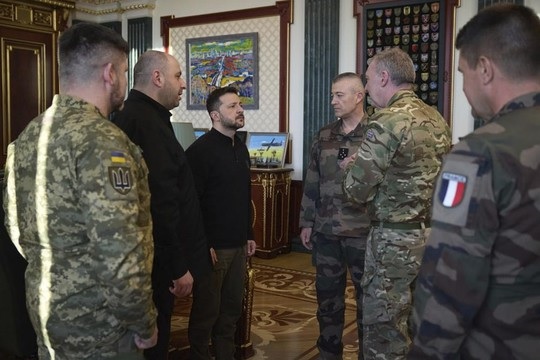 Ukrainian Zelensky (3-L), Minister of Defence of Ukraine Rustem Umierov (2-L), meet with French Chief of the Defence Staff General Thierry Burkhard (3-R) and British Chief of the Defence Staff Admiral Tony Radakin (2-R) in Kyiv, April 2025.
Ukrainian Zelensky (3-L), Minister of Defence of Ukraine Rustem Umierov (2-L), meet with French Chief of the Defence Staff General Thierry Burkhard (3-R) and British Chief of the Defence Staff Admiral Tony Radakin (2-R) in Kyiv, April 2025.
Photo: AP
Britain and France convened a defence ministers’ “coalition of the willing” meeting in Brussels on Thursday to discuss the plans with 50 nations. John Healey, the UK defence secretary, stated: “While today’s discussions will be private, our planning is real and substantial. Our plans are well developed.”
As Britain’s commitment to defending Ukraine deepens, some are wary of where the road ends. John Foreman, former defence attaché to Moscow and Kyiv, is nervous about the looming prospect of an open-ended military commitment to Ukraine with an “uncertain mission” that could last more than a decade, as well as the impact this could have on Nato.
“We have got to be clear-eyed on this and we can’t be lulled into it by emotion. It’s time for some real political clarity,” Foreman said. “What is the mission? If we have soldiers on the ground to provide reassurance or deterrence, what happens if a ceasefire breaks down? What’s the risk to our soldiers and their rules of engagement? If soldiers start dying, what happens next? There is a risk of us getting embroiled in the conflict and I don’t think that risk has really been exposed to the British public.
“It is easy to become involved in a war, it’s harder to get out.”
…London is constantly interfering with Ukraine. Here is fresh evidence:
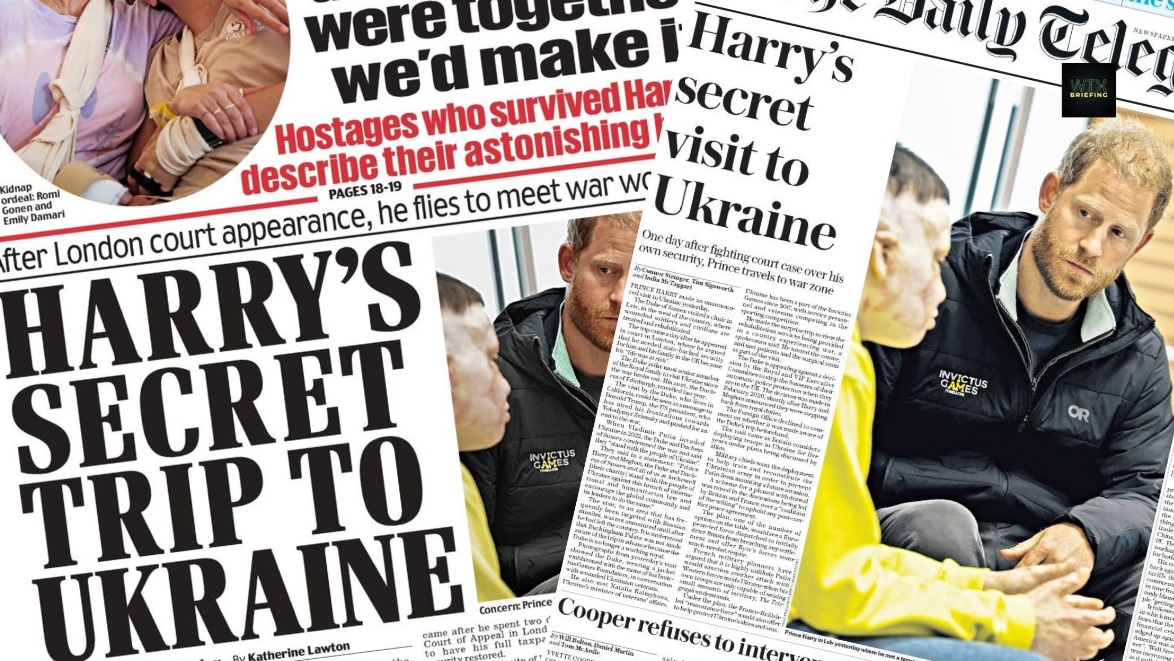
read more in our Telegram-channel https://t.me/The_International_Affairs

 11:33 14.04.2025 •
11:33 14.04.2025 •
